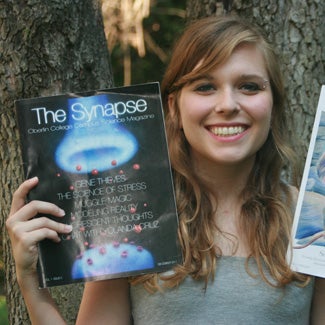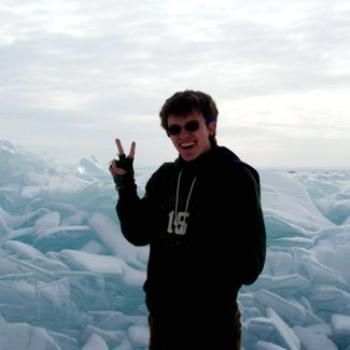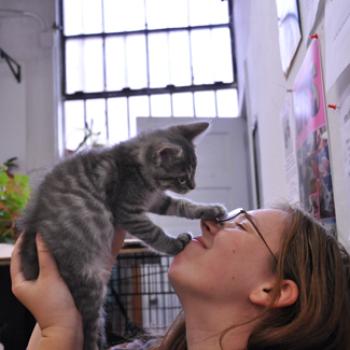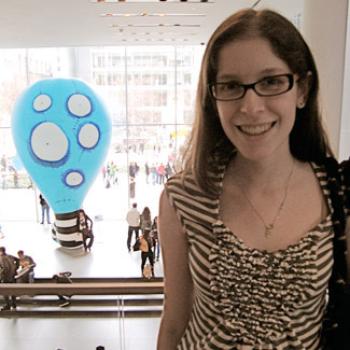On the creation of Synapse
Veronica Burnham ’14
“With these two “I want to do!” and “I can do!” revelations, I was set on it - I would create a magazine for science.”

In the summer before my entrance into Oberlin, I worked full-time in a chemistry lab that had a lot of down time. I would be given a few reactions to complete, would get all the materials and equipment together, set it up, begin the reaction ... and wait for two or three hours. I knew that Facebook would probably not be considered a good use of company time and computing power, so I sought another outlet to fill my time: reading about science. Be it academic journal articles, a feature in Discover magazine, or a Times piece, I was reading it all. Going online to race my way through an exciting Carl Zimmer piece or to drag myself laboriously through a technical journal article quickly became a habit, one which remained with me as I transitioned into my first year as an Obie.
Following this sort of summer, I ended up talking to my new classmates a whole lot about my recent discoveries about lovely, awesome, beautiful Science, which surprisingly did not turn me into a social pariah. Instead, my odd conversation starters were typically met with interest and acceptance, from science and nonscience students alike. A classmate of mine from a literature-based freshman seminar organized a “knowledge share” right before finals week our first semester. She posed it as an opportunity to relieve stress and to remind us all why we were doing this crazy thing called an Oberlin education. We gathered, a hodge-podge group of students, upon a rug in a tiny room. We drank tea, ate dried fruit, and each brought along a couple of things we had learned during the semester which really stuck with us. I, of course, brought stories from my introductory neuroscience class—about how the photoreceptors in our eyes function at a cellular level and allow us to see the world, about the fiber tracts that carry sensation from skin to mind. Like I’d encountered before, a number of people in the group agreed they were fascinated by some of the science I gushed about, but confessed they “weren’t a science person” and were turned off by the tenor of most science classes.
It was around this time that I began to fully appreciate the skill involved in writing about science for readers who were not specialists in the field. I began to think about how much I wanted to learn that skill. I came back in the second semester of my freshman year with the resolve to write about science, for the enjoyment of the scientist and nonscientist alike. Following this resolve with action, however, was a little more difficult than that; none of the publications on campus seemed to cover the sciences, and I didn’t know who to approach or when or how. Eventually, I began writing pieces which covered science events in the news section of the student newspaper, the Oberlin Review,. Although it was a good start, it was not exactly what I wanted to do. I wasn’t really covering science, I was instead reporting on lectures or events that covered science.
That April, I had two very distinct “pushes in the right direction.” The first of which was a journalism symposium, organized by a few staff members at the Review, that featured multiple panels and lectures by 16 Oberlin graduates who had all made it big in the journalism world, be it print or net or radio.
Among them was Robert Krulwich ’69, cohost and cofounder of NPR’s Radiolab,, a show dedicated, more or less, to making science accessible and applicable to a general audience. Krulwich talked about the creation of the show (which he did with another Obie, MacArthur genius Jad Abumrad ’95), and he demonstrated certain techniques they used on the show to make the information and interviews as entertaining and informative as possible. I squirmed in my seat and thought “I want to do that!”
The next omen from above came when I decided on a whim to attend an Oberlin-subsidized trip to Powershift, an enormous youth environmental conference held in Washington D.C. More than 200 Obies made a weekend trip to D.C. to hear lectures by leading climate experts and activists on the state of our environment, in addition to being trained in the basics of grassroots movements. A prominent theme of these movements was, “You can make a difference! You can institute change and take charge as an individual! Here is how you do that and how you get others involved!” So I squirmed cross-legged in my spot in the group powwow circle and thought, “I can do that!”
With these two “I want to do!” and “I can do!” revelations, I was set on it—I would create a magazine for science. I overcame the great hurdle of inhibition and approached a professor about my idea. While I didn’t receive immediate full-throttle support, I began to approach more professors and more students, and began to get a fuller picture of what I would need to start, create, fund, and distribute a new magazine. By the time my sophomore year rolled around, I was ready. Fate bestowed on me another gift, my coeditor-in-chief and cofounder Francis Lawrence ’14, who was as unabashedly go-getter as I was hesitant. He took the ideas I’d been hoarding to myself and taught me how to tell people about them, how to put them into action. For the past year, we have worked together as a balanced team, constantly learning from one another, and have put out two issues of full-color science literature, Synapse along the way.
Where my interests of science and writing once seemed disparate, they now appear complimentary. I still get odd responses when I tell nonObies what I’m planning to study (neuroscience and cinema studies), but I tell them, “Well, Oberlin’s just that sort of place.” I follow that with tales of the many multifaceted individuals I know here—a computer science/studio art double major who just took a class in the creation of art through mathematical algorithms, or the graduating senior who had done a combined honors project for two majors—neuroscience and dance.
I considered other, larger schools and universities, but I’m glad I ended up here at Oberlin. I don’t think a larger college would have afforded me the opportunity to create something like Synapse. Oberlin has given me a more integrated and inspiring education than I could ever have imagined.
Tags:
You may also like

On researching wolves in Minnesota
“We heard howls in the distance, howled in response, and heard the wolf pack reply to our call.”
Aaron Kokotek ’11

On combining love and science
“When I was starting work on my honors biology research with crayfish...I realized how many questions had been right in front of me at Ginko [Gallery] all the time.”
Sierra Zuber ’11

On being a biology tutor
“I like... seeing students become comfortable with the material so that they can enjoy it instead of just seeing the class as a source of stress.”
Abigail Lofchie ’12